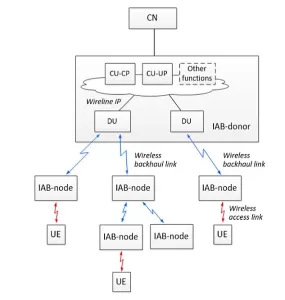Introduction
As 5G New Radio (NR) leverages gigahertz spectrum to unlock new potentials for mobile services, it faces inherent challenges such as reduced signal range and vulnerability to interference.
The transition from 4G’s extensive coverage to 5G’s high-frequency, limited-range networks necessitate a reimagined approach to radio access networks.

The concept of IAB is not entirely new; it builds upon the legacy of relay nodes introduced in LTE (Long-Term Evolution) standards. However, 5G IAB is designed to overcome the limitations of earlier implementations by supporting higher capacities, lower latencies, and more efficient integration with the 5G New Radio (NR) architecture.
3GPP (3rd Generation Partnership Project), the global standardization body that develops protocols for mobile telephony, has played a crucial role in the evolution of IAB technology. Starting from Release 16, 3GPP has incorporated IAB into the 5G NR standards, providing a framework for its implementation, operation, and optimization.
This introduction sets the stage for exploring IAB’s role in 3GPP Release 18, marking a significant advancement in overcoming deployment hurdles and enhancing connectivity.
Evolution of IAB in 3GPP Releases
The journey of Integrated Access and Backhaul (IAB) technology through the 3GPP releases showcases a progressive enhancement and adaptation to meet the evolving demands of mobile networks. This evolution reflects a shift from traditional backhaul solutions towards more flexible, scalable, and cost-effective alternatives, especially critical for the deployment of 5G networks in high-frequency bands.

Figure 1: Evolution of IAB in 3GPP Releases
The conceptual foundation for IAB was laid with the introduction of relay nodes in LTE, as specified in 3GPP Release 10. Relay nodes were designed to extend coverage and enhance capacity at cell edges by relaying signals between a base station and user equipment (UE) in areas where direct communication was inefficient or impossible. While effective in improving coverage and throughput, LTE relaying was primarily focused on access links and did not address the challenges of backhaul connectivity in the context of dense 5G deployments, particularly in mmWave spectrum.
Recognizing the need for a more integrated approach to access and backhaul in 5G networks, 3GPP introduced IAB technology in Release 16. This marked a significant shift towards leveraging the same mmWave spectrum for both user access and network backhaul, a move that was critical for the efficient use of high-frequency bands. IAB in Release 16 laid the groundwork for deploying self-backhauling base stations, capable of dynamically allocating spectrum resources between access and backhaul links based on real-time traffic demands.
The technical specifications of IAB developed in Release 16 encompassed several key components, including the architecture of IAB nodes, the protocols for access and backhaul operations, and the mechanisms for dynamic resource allocation. These specifications detailed the functionality of IAB nodes as both providers and consumers of backhaul connectivity, supporting flexible network topologies and enabling efficient spectrum utilization.
One of the pivotal aspects of the IAB specification was the introduction of a split architecture for IAB nodes, distinguishing between the IAB-donor, which connects to the core network, and the IAB-node, which relays traffic to and from UEs and other IAB-nodes. This architecture facilitated the deployment of dense networks with high capacity and coverage, leveraging the inherent advantages of mmWave spectrum while mitigating its limitations.
As we move forward, the enhancements introduced in 3GPP Release 18 further build upon the foundation laid by Release 16, addressing the evolving needs of 5G networks and introducing new capabilities to maximize the potential of IAB technology.
Technical Innovations in Release 18
3GPP Release 18, often referred to as “5G Advanced,” marks a significant step forward in the evolution of 5G technology, introducing a range of enhancements that promise to elevate network performance, efficiency, and flexibility to new heights. Among these advancements, the improvements in Integrated Access and Backhaul (IAB) technology stand out as a key area of development, offering innovative solutions to some of the most pressing challenges in deploying 5G networks, especially in mmWave spectrum.
One of the hallmark innovations in Release 18 is the introduction of a more decomposed RAN architecture and IAB Node and Donor Configurations, which enhances the flexibility and scalability of IAB deployments.
This model further disaggregates the traditional base station components into more granular elements, such as the Radio Unit (RU), Distributed Unit (DU), and Centralized Unit (CU). This decomposition aligns with the broader industry trends towards Open RAN and virtualization, enabling more efficient resource utilization and network management.
In the context of IAB, the decomposed RAN model allows for a more flexible allocation of backhaul and access resources, facilitating dynamic adjustments based on varying traffic conditions and network demands.

IAB Node and Donor Configurations enhancements in Release 18, with new protocols and algorithms designed to minimize interference between access and backhaul links, as well as between neighboring IAB nodes.
These improvements are crucial for maintaining high throughput and low latency in dense network environments, introducing more efficient handover procedures and better support for UEs moving across different IAB nodes.
This ensures seamless connectivity and service continuity for mobile users, enhancing the user experience in 5G networks.
The technical innovations in Release 18 represent a significant leap forward in the capabilities and performance of IAB technology.
By addressing key challenges and leveraging the latest advancements in RAN architecture and network protocols, Release 18 sets the stage for more efficient, flexible, and scalable 5G deployments, particularly in challenging environments and high-frequency bands.
General Architectural Overview
The IAB network architecture marks a significant advancement in 5G networks, introducing access and backhaul links. Access links connect user equipment (UE) with IAB nodes or donors, whereas backhaul links connect parent and child IAB nodes. The parent node schedules downlink/uplink (DL/UL) traffic for both types of links, with the child node handling DL/UL scheduling to its UEs.
IAB nodes can operate in Stand-Alone (SA) or Non-Stand-Alone (NSA) modes, utilizing dual connectivity for enhanced network integration. The IAB structure aims to incorporate existing network functions and interfaces, including the CU/DU split architecture, to streamline its deployment within 5G networks.

Figure 2: IAB Architecture
The architectural overview in Release 18 for IAB technology emphasizes the integration of Open RAN principles, facilitating a more flexible and scalable network infrastructure.
This architecture separates the Distributed Unit (DU) from the Central Unit (CU), with DUs present in IAB nodes to manage access and backhaul functions efficiently. This separation ensures that backhaul traffic is isolated within a constrained topology, preventing routing issues from affecting the core network or adjacent nodes, thereby enhancing network reliability and performance.
Use Case and Applications
IAB deployment offers significant benefits for network operators and enterprises, facilitating flexible network expansion and enhanced service delivery. Case studies reveal its effectiveness in diverse scenarios, including urban areas with dense networks and remote locations lacking traditional backhaul infrastructure, underscoring IAB’s impact on operational efficiency and service quality.
As service providers advance from initial 5G deployments to enhancing network capacity, they encounter the challenge of securing high bandwidth backhaul solutions efficiently and cost-effectively.
Integrated Access and Backhaul (IAB) technology, especially with the advancements in 3GPP Release 18, emerges as a pivotal solution. It addresses the challenges posed by mmWave-based 5G deployments, such as the need for dense antenna networks due to shorter signal ranges.

Figure 3: IAB for mmWave deployments
Release 18 enriches IAB with improved support for cell densification, filling coverage holes, extending network coverage in strategic locations like streets or highways, and providing infrastructure on demand for temporary events or specific needs.
This enables service providers to deploy 5G networks more flexibly and economically, enhancing network capacity and coverage without the extensive costs associated with traditional backhaul solutions.
Conclusion
The advancements in 5G IAB technology as outlined in 3GPP Release 18 represent a pivotal evolution in the deployment and enhancement of 5G networks. This release not only addresses the inherent challenges of high-frequency, mmWave-based 5G deployments, such as reduced signal range and vulnerability to interference, but also sets a new benchmark for network performance, efficiency, and flexibility.
By building upon the foundational concepts introduced in earlier releases, particularly the integration of access and backhaul functionalities within the same spectrum, Release 18 brings forth a more decomposed and flexible RAN architecture. This innovation, coupled with the refined configurations of IAB nodes and donors, significantly enhances the capability to dynamically allocate backhaul and access resources, thereby optimizing network management and resource utilization in real-time traffic conditions.
The introduction of a decomposed RAN model aligns with the broader industry trends towards Open RAN and virtualization, facilitating a scalable and efficient network infrastructure.
Furthermore, the practical applications and operational benefits of IAB technology, as demonstrated in various case studies, underscore its effectiveness in not only urban areas with dense networks but also in remote locations lacking traditional backhaul infrastructure. The ability to deploy 5G networks more flexibly and economically, without the extensive costs associated with traditional backhaul solutions, marks a significant step forward in realizing the full potential of 5G.
As the industry moves towards more advanced stages of 5G deployment, the innovations introduced in this release will play a crucial role in overcoming deployment hurdles, ensuring that the promise of 5G technology is fully realized in a variety of operational environments and application scenarios. The future outlook for 5G deployment and IAB technology appears promising, with ongoing advancements poised to further revolutionize mobile connectivity and services.
References
- Xingqin Lin, “An Overview of 5G Advanced Evolution in 3GPP Release 18”, IEEE Communications Standards Magazine
- 3GPP TS 38.401, “NG-RAN; Architecture description,” V16.3.0, Release 16, Nov. 2020.
- 5G Americas White Paper, “Innovations in 5G Backhaul Technologies, IAB,HFC & FIBER”
- F. Monteiro et al., “Paving the way toward mobile IAB: Problems, solutions and challenges,” IEEE Open J. Commun. Soc., vol. 3, pp. 2347–2379, 2022.
- 3GPP, “Study on New Radio Access Technology: Radio Access Architectures and Interfaces. 3GPP Technical Specification,” 3GPP, 2018.

